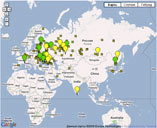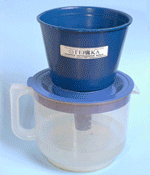Статьи по темам
Фотогалерея
Bio-electrographic method in detecting heterogeneity and unique features in autism
2009 г.
Kostyuk N., Rajnarayanan R., Isokpehi R., Korotkov K.,
Howcroft S., Yeager M., Mann H., Cohly H.
According to the U.S. Dept. Developmental Services, the prevalence of autism spectrum disorders increased 556% from 1991 to 1997. One in every eighty boys has autism (boys are affected 4 times as often as girls). One out of every sixty-eight families has a child with autism. Autism is increasing by 3.8% per year worldwide and 15% in the USA. It covers a continuum of disorders beginning from severe autism to mild autism and Asperger’s syndrome. Autism is defined only behaviorally, which often contributes to the heterogeneity of cohort studies. Factors such as age, gender, IQ, and behavioral traits often diverge considerably, with non-uniform matching of controls.
The six autistic patients, their parents, and siblings examined in our preliminary studies, exhibited a unifying lower level of electro-photonic emission in the sectors of the fingertips corresponding to cerebral cortex and cerebral vessels while showing heterogeneity in responsiveness to the stimulation by the electromagnetic field.
The Institutional Review Board (IRB) approval of the consent form was obtained according to the guidelines prescribed by the Review Board. All participants were residents of Mississippi. The participants of the study and their parents were informed that the results will be published in a medical book or journal, or used to teach others. The age of autistic children fell into a range from five to twelve years old, 9.3 the mean age. All autistic participants were males.
The study was conducted by using an electro-photonic impulse analyzer "GDV Compact". Each participant was asked to place fingers correctly on glass surface. The pictures of electro-photonic emission (EPE) of all ten fingertips were taken twice – without and with plastic film. The screenings of autistic children were done randomly.
Results revealed heterogeneity and unique features in the participants with ASD and their parents. The unique signature in our preliminary study for ASD was related to misbalance in the zones gastro-intestinal tract, immune system, cerebral cortex, and cerebral vessels. Additionally, the bio-electrographic study detected epiphysis, kidneys, adrenal gland, cervical zone, thorax zone and sacrum as the zones of misbalance in autistic children.
As to their parents, they showed misbalance of electro-photonic emission in the zones of cerebral cortex and cerebral vessels. The heterogeneity was observed in variability of values assigned for the same organ within the same phenotype.
Discussion
Patients with autism can differ in the severity and scope of their symptoms, suggesting that multiple factors contribute to explaining the disorder's symptoms. Autistic children have abnormal cerebral blood flow.
The low activities that we found in the zones of gastro-intestinal tract, immune system, cerebral cortex, and cerebral vessels have been described in the literature and confirm previous data on autistic patients. These zones were found to be present in all autistic children we tested and therefore are unique signatures of autism in our preliminary study. Additionally, the bio-electrographic study detected epiphysis, kidneys, adrenal gland, cervical zone, thorax zone and sacrum as the zones of misbalance in autistic children. Despite of being diagnosed with Asperger’s syndrome/mild autism, autistic children had different values assigned to the zones of cerebral cortex and cerebral vessels. This indicates that there exists heterogeneity within one phenotype which implies the individualized approach. The uneven distribution of EPE especially as to the response of the parasympathetic nervous system leads us to hypothesize that there exists a misbalance, which is expressed on the physical level in respective zones of EPE.
Brothers and sisters of the autistic children though labeled as normals also exhibited unique features common to autistic sibling but additionally had low activities in pancreas and pelvis minor zone. The only difference between the autistic children and their siblings is in the distribution of EPE values. In autistic children the distribution is very uneven between left and right hand while in the siblings the distribution is fairly even.
The fathers of the autistic children share some unique features of autism such as cerebral cortex, cerebral vessels, epiphysis and spleen. Characteristically fathers show low activities in the liver, transverse colon, descending colon, respiratory system, cardiovascular system and coronary vessels.
Mothers of the autistic children share some unique features of autism such as cerebral cortex, cerebral vessels, immune system, epiphysis and kidneys. Distinguishing features include transverse colon, pancreas, and urogenital system. The images were characterized by inconsistency and gaps pertaining to certain sector. The outer isoline of some images had fractile nature which could be the evidence of emotional tension or stress.
In conclusion, bioelectrographic method is a promising step towards creating autism profile and identifying unique signatures pertaining to the parents and their siblings. Further work should involve more participants in order to augment our findings by the bioelectrographic approach.
- Войдите или зарегистрируйтесь, чтобы получить возможность отправлять комментарии





 Нанотехнологии в водоочистке: достижения отечественной науки на службе здоровья.
Нанотехнологии в водоочистке: достижения отечественной науки на службе здоровья.
 Фильтры для воды "Геракл" с графеновым сорбентом: полный каталог и прайс-лист.
Фильтры для воды "Геракл" с графеновым сорбентом: полный каталог и прайс-лист.



